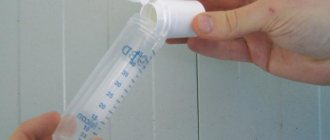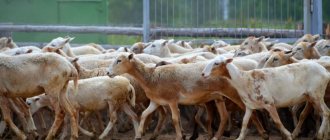Dear goat breeders!
The first goat seed bank appeared in Russia. It is organized at the All-Russian Collection of Genetic Material (Transgenbank) and is located at the Institute of Gene Biology of the Russian Academy of Sciences. The goat semen bank contains sperm from breeding animals of domestic and foreign selection. This was preceded by a lot of preparatory work to study domestic and world experience in deep freezing of animal semen. First of all, our activities will be aimed at mass insemination of goats in farms and livestock complexes with a population of 100 or more goats. During the breeding period, our specialists will come to the goat farms and ensure the preparation of the queens for insemination. After this, our highly qualified livestock technicians will inseminate the goats. We are also considering the possibility of organizing the insemination of goats on small farms, and even individual goats on peasant farmsteads, where we are forced to constantly keep home-grown goats, which, on the one hand, are not capable of increasing the milk productivity of goats, and on the other, lead to undesirable closely related animal crossing. We have begun the selection of breeding goats from which the seed will be collected. Negotiations are underway with holders of breeding goat seed abroad. The Russian Ministry of Agriculture is actively helping us in this work. We are currently conducting a preliminary assessment of the need for Russian goat breeders to use the method of artificial insemination of goats. Wait for your offers.
President of the Golden Goat Association Igor Goldman
Moscow, January 2009
Repository of semen of breeding goats.
Insemination of a pig at home
Farmers on small plots use a simplified method of artificial insemination.
You will need a catheter with an attachment and a container with seminal fluid. Large industries use elongated plastic tubes with a special cap to which a catheter can be attached - you can choose just such a tool. Catheter for inseminating a pig at home
Sperm collection
Young mature boars are sent to mating several times to conceive naturally, then they begin to accustom them to a doll in the form of a female. Soon they develop a reflex, the animals begin to mount the toy.
Stuffed animal for boar
Step 2. Attach a hole in the stuffed animal that imitates a vagina. It must have the necessary pressure and the ability to organize sliding. To maintain a comfortable temperature, place an electric heater with a regulator inside the stuffed animal.
Step 3. Cover the hole on top with a film secured with a rubber ring. Bring the male indoors.
Collection of sperm from a boar for insemination
Secure the pig in a special pen. During the process, you should adhere to the principles of sanitation: first clean the stall, wear sterile gloves, use only clean tools. If the genitals become infected, the number of embryos may be reduced and the female is more likely to produce dead or diseased offspring. Rinse your genitals with clean warm water. Using a swab, wipe them with furatsilin solution, then wipe dry with a clean towel.
Boar sperm prepared for insemination
Stroke the female on the sides, but do not touch the back area. The animal will prepare for fertilization and will not kick or behave aggressively. By stroking the pig's body, you help increase oxytocin, which will help the reproductive organs more efficiently accept the seminal fluid as it is delivered.
Sow stimulation
Lubricate the ends of the catheter with a special moisturizing gel. Do everything carefully, calmly, do not make sudden movements that could cause pain to the animal.
| Step | Description |
| 1 | Place the catheter shaft into the animal's genital opening, pointing the instrument upward. Move it further until you feel a slight resistance - this is the uterus. |
| 2 | Turn the tool counterclockwise, then turn the bottle with the seed over and squeeze it out of the reservoir. Take your time - everything can take from three to five minutes. |
| 3 | If too much fluid flows back, slow down or reposition the catheter by turning it a quarter turn, then continue injecting. |
| 4 | Remove the tool by pulling it towards you and rotating it clockwise. If you wish, you can leave the catheter in the vagina for a few minutes. |
Fertilizing a pig at home
After the procedure, leave the animal for several hours, do not touch it or offer food. Allow the sow to calm down and rest, then feed the pet. After a day, you can repeat the procedure and inject a second portion of the boar’s seminal fluid. If after 20-25 days the female does not go into heat, most likely, conception was successful. Remember that the conditions for keeping a pregnant female must be special: the room is clean and warm, there are no drafts, the diet is balanced.
Rest of pigs after artificial insemination
Preparing rams for mating
The rams must also be switched to an enhanced diet, and about a month (or 40 days) before the expected mating, they must begin to be given concentrated feed, in an amount of at least one kg per day per head.
Breeding rams must have factory fatness.
In addition, producers must be provided with diets balanced in all nutrients; during this period, it is important to protect them from high external temperatures and prolonged solar radiation, which significantly reduce the quality of sperm
During the preparation period of rams, the quality of sperm is assessed once every five days, and before the start of p.o. - in one day. On the day of the study, the ram is prescribed two sessions on the artificial vagina with an interval of 10-15 minutes. No later than 2 weeks before the start of mating, in accordance with the breeding work plan, breeder rams are allocated for each flock of queens.
In breeding herds, for each flock of queens, 4-5 breeding rams from the main lines are selected with individual selection, and then queens are selected for them according to the records in individual cards.
The right drum is capable of performing at least 10 services in 8 hours, and some can do 20 or more.
In commercial herds, as well as in class breeding herds in breeding farms, the allocation of rams for mating is used by flocks. In accordance with the class and productivity of the queens, one main and one reserve ram are assigned to the flock, which is assigned to the flock at the p.o. used only in exceptional cases. In breeding farms and breeding farms (on farms) it is recommended to use only p.o. freshly obtained sperm during two sexual cycles (35...40 days).
If necessary, manual mating or free mating of queens that have not been fertilized by artificial insemination is carried out after the point is closed for 15...20 days, and rams are used that are not inferior in quality to the main ones. In order to guarantee the receipt of offspring from assigned highly productive breeding rams, it is recommended to use vasectomized sampler rams for culling queens in heat.
To avoid premature insemination, animals must be separated for some time.
To ensure the rational use of the most valuable rams of state breeding plants, it is necessary to create central points (laboratories) for them, the task of which should be to transport freshly received diluted or short-term (within 2-3 hours) stored sperm to nearby commercial farms during prebreeding preparation rams and storage of frozen semen from outstanding producers in the winter-spring period.
Note! Work at these points is organized by farm specialists together with breeding associations
Also, silage and dry mixtures should be introduced into the diet of animals being prepared for mating.
It is very important for breeding rams to be in the factory stage of fatness throughout the year. Even during the period between matings, male sires should not be limited in adequate nutrition.
During the mating period of sheep, crushed root vegetables (potatoes, carrots), as well as a mixture of grains (barley, millet or oats) and cake, are well suited for feeding rams. Dry foods can either be diluted or simply fed separately. Also during this period, the ram needs salt, bone meal, chicken eggs and other additives. Of course, all types of feed must be of the best quality and always fresh.
Since diet directly affects sperm quality, breeding sires need to be constantly monitored and the quality and quantity of semen should be regularly assessed. At the first sign of a decrease in any of the listed indicators, the feeding diet should be urgently changed.
How can you tell if a goat is pregnant?
At home, it is quite difficult to understand whether conception has occurred or not (especially for a novice goat breeder). During the first weeks of pregnancy, the animal behaves as usual, there are practically no external signs. However, there are several signs by which one can still assume the successful covering of a goat:
- after the hunt, the milk yield returns to its previous level;
- three weeks after mating, the heat does not appear;
- over time, the goat’s belly swells and its asymmetry appears;
- external reproductive organs increase in size, skin folds in the vaginal area are smoothed out;
- the pelvic bones expand and the ligaments weaken;
- with the onset of the second half of pregnancy, palpating the uterus can reveal its significant enlargement or the fetus itself;
- After some time, the goat’s behavior becomes calmer, she tries to walk less and lie down more, and her appetite noticeably improves against the background of this behavior.
More on the topic: Breeds of hornless goats
Based on such signs, you can with a high probability independently determine that the goat has covered itself successfully.
If you need more confidence, you can donate blood or milk for laboratory analysis, and in the early stages, do an ultrasound.
However, both of these methods are not always available.
Preventive measures to prevent the spread of diseases
To prevent the goat from becoming infected with an infectious disease, the following manipulations are performed before artificial insemination:
- instruments and materials stored in sealed containers are carefully treated with an antiseptic solution;
- the employee is given a clean medical gown, a cap to hide his hair under, and sterile rubber gloves for one-time use;
- the vaginal area of the goat is washed with a 0.02% solution of the drug “Furacilin”;
- The external genitalia of the animal are thoroughly wiped with a clean cotton towel.
See also
Is it possible to keep a goat in an apartment, suitable breeds and pros and consRead
How to inject sperm
There are two options for AI for goats: vaginal and cervical. How is one different from the other?
During vaginal insemination, sperm is injected directly into the deep part of the vagina using a syringe catheter or pipette. A vaginal speculum, unlike the cervical method, is not used.
In the second method, the seed is injected into the cervical canal. This technique is considered better, since it is possible to control the condition of the ovaries. Today, this option is used more often than others, not only for artificial insemination of goats, but also other animals.
Period after insemination
Fertilization of the egg occurs within 2-6 hours. From the moment of sexual intercourse, the females are transferred to a separate room and allowed to rest for 4 hours. Her condition is monitored for 3 months and kept separately from the herd.
If the insemination attempt was not successful, the female enters heat after 20-30 days. In such cases, the manipulations are repeated. If there is no result at the 3rd time, a detailed examination of the animal is carried out for pathologies of the reproductive system.
In 20% of cases, embryos die in the first month from the moment of insemination. The hunt comes in 40-45 days. During this period, it is necessary to carry out fertilization again, otherwise the cow will become barren.
Signs of pregnancy can be diagnosed as early as 3 weeks
The cow begins to behave cautiously, her gait changes, she avoids other animals, and eats more. Rectal examination reveals an enlarged uterus
The most reliable way to determine pregnancy is to take a blood test. Elevated progesterone levels will indicate pregnancy.
Artificial insemination of a cow
Artificial insemination of cows 2
Artificial insemination of cows 4
artificial insemination
Synchronization of hunting and artificial insemination of beef cattle in the peasant farm of Alexander Moskvin.
Artificial insemination of sheep
Diagnosis of estrus, heat and ovulation. Sheep's estrus is short-lived and difficult to detect. It is manifested by hyperemia of the mucous membranes, an increase in the number of layers of the vaginal epithelium and keratinization of surface cells, sometimes pinpoint hemorrhages, increased tone of the uterine muscles, and increased secretion of mucus by cervical cells. The mucus at the beginning of the hunt is transparent, slightly opalescent, then becomes more cloudy and at the end of the hunt acquires a lard-like consistency.
Sexual heat in sheep is not as pronounced as in other species, and it is almost impossible to determine it in most animals without a sample ram. It is accompanied by the release of specific odorous substances - attractants (pheromones), which are easily perceived by males, and lasts 36–38 hours (from 12 to 72 hours).
Sheep in heat clatter their hooves, wag their tails, try to get closer to the breeder, and sometimes follow the ram in a group. A sheep is considered to be in heat if it allows the ram to be mounted.
Goats have much in common with sheep in the manifestation of sexual function. However, sexual cyclicity is often irregular, with a cycle lasting 19–21 days, although shorter cycles (5–9 days) are also possible. The hunt lasts 22–33 hours; Ovulation occurs 27–34 hours after the start of heat.
To detect heat in sheep, sampler rams are used. To prevent the ram from inseminating the sheep, but only to indicate heat, an apron made of dense material, 60 cm long and 40 cm wide, is tied to his stomach. Sometimes a vasectomy is performed. One sampler is prepared for 80–100 ewes. Young, energetic rams are usually used. If the ram is not vasectomized, then its breeding value should be at least class 1. Before starting work, both intact and vasectomized rams have aprons tied under their bellies to prevent coitus. To facilitate the process of sampling sheep during the hunt, dye taps are attached to the samplers in the chest area. When mounting sheep, the rams color them using such devices. If vasectomized rams are not tied with aprons, then inhibition of sexual reflexes does not occur as quickly and does not occur as often as in rams with aprons. Moreover, multiple coitus enhances the contractile function of the uterus in sheep and accelerates ovulation, which makes it possible to limit one-time insemination instead of the usual two-time insemination. During the sexual season, to maintain sexual activity, intact sample rams are allowed to mount one uterus per week in heat, or one or two ejaculates are received from him into an artificial vagina.



